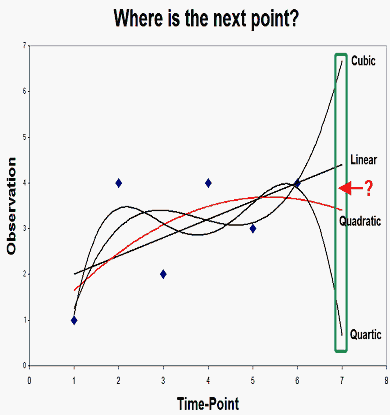
Students stumble over the meaning of "overfit", indicated in Rasch program output by negative t-statistics and mean-squares less than 1.0 (chi-squares less than their d.f.). This is an aspect of Rasch measurement which sounds strange to analysts familiar with conventional descriptive statistics and model-building.
The nearest thing to overfit in conventional statistical analysis (which fits models to data) is over-parameterization. But statistics courses usually spend little time discussing this problem, so the students imagine that "the better the fit, the better the model!" In building statistical models, they may be instructed to choose between better and worse fitting models, but they are rarely told to reject a model because its fit is "too good".
A demonstration of over-parameterization is to put some points on an x-y plot, then fit a series of polynomials with more and more terms to those points. It becomes obvious that too many terms actually make prediction of a new point (especially one extrapolated outside the range of the current points) worse, not better.
Here is an example. The observations for 6 time-points are plotted. What is our prediction for the next time-point? The 4 trend-lines are polynomials fitted to the observations. The higher-order is the polynomial, the better is its the fit to the existing points, but, beyond the quadratic, the worse the prediction of the next point.
In Rasch, we are fitting data to models, so the Rasch equivalent to overfit due to over-parameterization is overfit due to redundancy (over-predictability) in the data.
Based on a comment by Steve Walter, Graduate Institute of Applied Linguistics.

Conceptualizing Overfit or Over-parameterization … S. Walter, Rasch Measurement Transactions, 2008, 22:2 p. 1165
| Forum | Rasch Measurement Forum to discuss any Rasch-related topic |
Go to Top of Page
Go to index of all Rasch Measurement Transactions
AERA members: Join the Rasch Measurement SIG and receive the printed version of RMT
Some back issues of RMT are available as bound volumes
Subscribe to Journal of Applied Measurement
Go to Institute for Objective Measurement Home Page. The Rasch Measurement SIG (AERA) thanks the Institute for Objective Measurement for inviting the publication of Rasch Measurement Transactions on the Institute's website, www.rasch.org.
| Coming Rasch-related Events | |
|---|---|
| Apr. 21 - 22, 2025, Mon.-Tue. | International Objective Measurement Workshop (IOMW) - Boulder, CO, www.iomw.net |
| Jan. 17 - Feb. 21, 2025, Fri.-Fri. | On-line workshop: Rasch Measurement - Core Topics (E. Smith, Winsteps), www.statistics.com |
| Feb. - June, 2025 | On-line course: Introduction to Classical Test and Rasch Measurement Theories (D. Andrich, I. Marais, RUMM2030), University of Western Australia |
| Feb. - June, 2025 | On-line course: Advanced Course in Rasch Measurement Theory (D. Andrich, I. Marais, RUMM2030), University of Western Australia |
| May 16 - June 20, 2025, Fri.-Fri. | On-line workshop: Rasch Measurement - Core Topics (E. Smith, Winsteps), www.statistics.com |
| June 20 - July 18, 2025, Fri.-Fri. | On-line workshop: Rasch Measurement - Further Topics (E. Smith, Facets), www.statistics.com |
| July 21 - 23, 2025, Mon.-Wed. | Pacific Rim Objective Measurement Symposium (PROMS) 2025, www.proms2025.com |
| Oct. 3 - Nov. 7, 2025, Fri.-Fri. | On-line workshop: Rasch Measurement - Core Topics (E. Smith, Winsteps), www.statistics.com |
The URL of this page is www.rasch.org/rmt/rmt222b.htm
Website: www.rasch.org/rmt/contents.htm